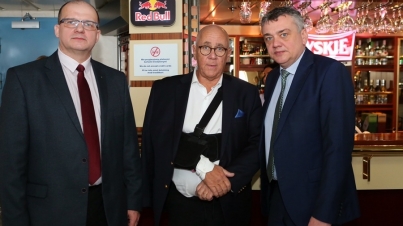News
News
People
Presentations
After Hours
Calendar
Currencies
Galleries
Advertising
About us
Contact
Adressess
Newsletter
Poor harvests
“It has never been so bad”, say farmers about this year’s grain prices and count their losses.
 Low crops prices are the reason of Western-Pomeranian farmers' problems /arch/
Low crops prices are the reason of Western-Pomeranian farmers' problems /arch/
Although this year’s crops have been several dozen percent higher, the level of prices offered by purchase points has not been so low for years. Last year, the price of approx. PLN 620 per a ton of wheat was not surprising. The prices paid at present for consumption (standard, bread) wheat and feed wheat are similar, remaining at the level of approx. PLN 420 per ton. This year’s price of premium class wheat (A) is approx. PLN 440 – 450 per ton. What is scarce, however, is top quality wheat (good density and high protein content), whose price reaches the level of PLN 520 per ton and whose availability in the market is limited.
“We store all the crops, waiting for more attractive prices”, says Stanisław Dycha, chairman of the Pedigree Breeding Center in Lubiana, in the municipality of Pełczyce. The farm extends over the area of 2.8 thousand hectares of arable land and 3.4 thousand hectares of grassland. “Last year we recoded a profit of PLN 1.4 million, this year it’s only wishful thinking. Compared to last year's prices, we will incur losses of about PLN 3-4 million, on the assumption that production will be at the level of 9 thousand tons. Bottom grain prices are accompanied by low milk prices, which have fallen by a half. Last year PLN 1.50 was paid per liter, while this year’s price was as low as PLN 0.80 per liter As we produce 8 million liters of milk a year, the related loss is approx. PLN 3 million”, adds Dycha. In his view, larger farms finance their operations with the profits generated on sales of last year’s crops (sold in mid-year). Financing problems are likely to occur in a few months.
“Although the average grain crops were 20% higher, the prices make producers’ position dramatic. I cannot recall so low prices over the last 20 years", says Roman Kobyliński, chairman of J.W.Agro in Nowogród, owner of a farm extending over 2.5 thousand hectares of land.
“I think we haven’t seen such prices since 1989”, confirms Edward Sadłowski, a farmer from Bielice performing the function of chairman of the West Pomeranian Chamber of Agriculture. “Taking into account the costs, not everyone can store their grain in a silo. Smaller-scale farmers were forced to sell grain at such low prices as they do not have enough money for further field work”, he adds.
Conspiracy, speculation or the market?
What affected this year’s grain prices?
“The market keeps prices artificially low in order to make a profit on grain in the following months. The consumption level in Poland is relatively constant and the impact of overproduction on prices should not be so dramatic”, reckons Stanisław Dycha.
“In my view, the fact that prices are suspiciously low reflects the reactions of leading global companies to the crisis and is a sign of trade conspiracy. Large companies decide on the price level and wait, while Polish farmers and authorities are not in the position to affect them. Grain will be the subject of market play over the next few months. Just like oil and raw materials. No one is going to pay more and then lose”, says Roman Kobyliński.
“Grain prices are affected by the level of animal production”, states iBogusław Gołębiowski, PhD, from the Faculty of Economy at the West Pomeranian University of Technology. “This year’s grain prices have been dramatically low. I can’t recall when a ton of oat cost PLN 160. Although the supply in the grain market is significant, what also matters is the situation in the animal market. The swine population has decreased. At the end of previous year livestock prices were low and stock-breeding unprofitable. Cattle breeders faced serious problems due to low milk purchase prices (as low as PLN 0.70 per liter). Farmers reduced herd population due to animal leukemia. Limited fodder purchases and higher crops led to greater supply and low grain prices”, says Gołębiowski.
Waiting for the prices to rise
Experts claim that this year, instead of saving on fertilizers, farmers should have focused on improving the quality of grain.
“Had plants been provided with all the components affecting the content of protein and appropriate density, a good price would have been achieved. However, the quality of crops is poor as the amount of nitrogen and microelements was not sufficient. Although the crops were high, exceeding even 10 tons per hectare, the low price did not compensate for producers’ losses. As regards production profitability, its level was minimum”, claims Bogusław Gołębiowski.
Low prices meant lost profits for the farmers and higher crops did not ensure significant compensation for such losses. According to calculations of experts from the West Pomeranian Agricultural Advisory Services Center in Barzkowice, to guarantee minimum profits, the price paid for a ton of wheat ought to be at least PLN 550, assuming the minimum output of 6 tons per hectare. Subsidies provided to farmers correspond only to a portion of the production costs. It should be borne in mind that the prices paid for agricultural production materials, fertilizers, pesticides and fuel rise by approx. 10-15% a year. However, the price of grain fell by almost a half compared to the previous year. According to the data published by the Central Statistical Office, in August 2009 a 14% wheat price decrease was recorded compared to July, and the price of rye fell by over 17%. Compared to August 2008 the wheat price in purchase points was over 21% lower (in marketplaces almost 35% lower), and the price of rye was lower by over 40%. Fast increases in the animal production and greater demand for fodder should not be expected. “Higher livestock prices will translate into growing grain prices, however the change will be far from dramatic - EUR 10-20 per ton at the most”, forecasts Bogusław Gołębiowski. Storing the crops and waiting for the prices to rise may turn out to be the only solution. However, the number of farmers having their own silos is insignificant, while storage services involve additional costs.
He grain market resembles the capital market
The position of farmers associated in producer groups is the most favorable, however only several such groups operate in the region. Those farmers could negotiate prices and consider entering into contracts.
“Some farmers applied the above solution. However, it should be borne in mind that obligations under such contracts have to be met, otherwise penalties apply. If hail destroyed crops, grain would have to be bought in the market to meet the contractual obligation. Another option is to sign a sales contract for 30% of crops, which reduces the risk and ensures a higher price for the farmer for a portion of crops”, explains Bogusław Gołębiowski.
Association in producer groups has been discussed for several years but farmers are not particularly willing to participate. To be a respected market player, a group should have access to approx. 5 thousand hectares of land. Confidence to the group leader who will be responsible for taking decisions regarding grain sale at a given time is also of key importance. As grain prices change overnight, it is worth to keep a track record and take appropriate decisions. The grain market, also at the regional level, is becoming similar to the stock exchange. Maximum profits may be guaranteed only for those farms whose owners understand and are prepared for the above trend.
ptr












































